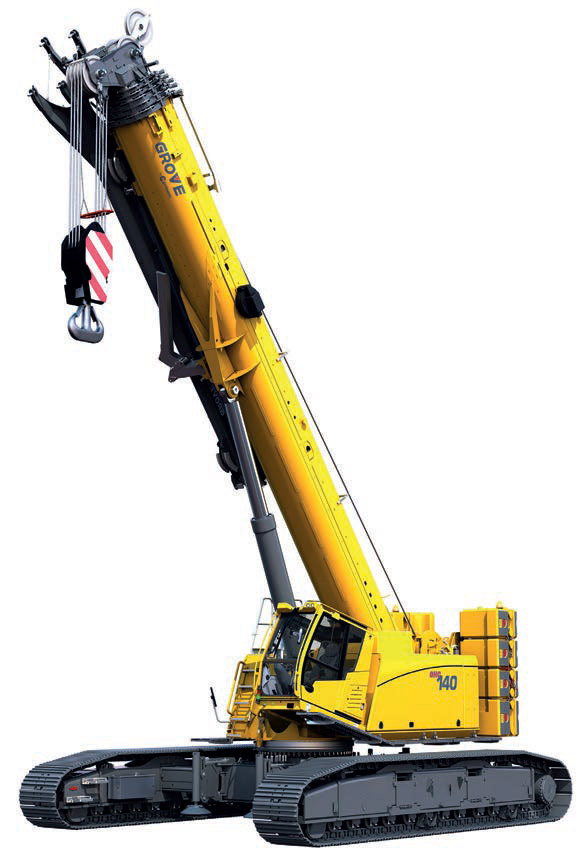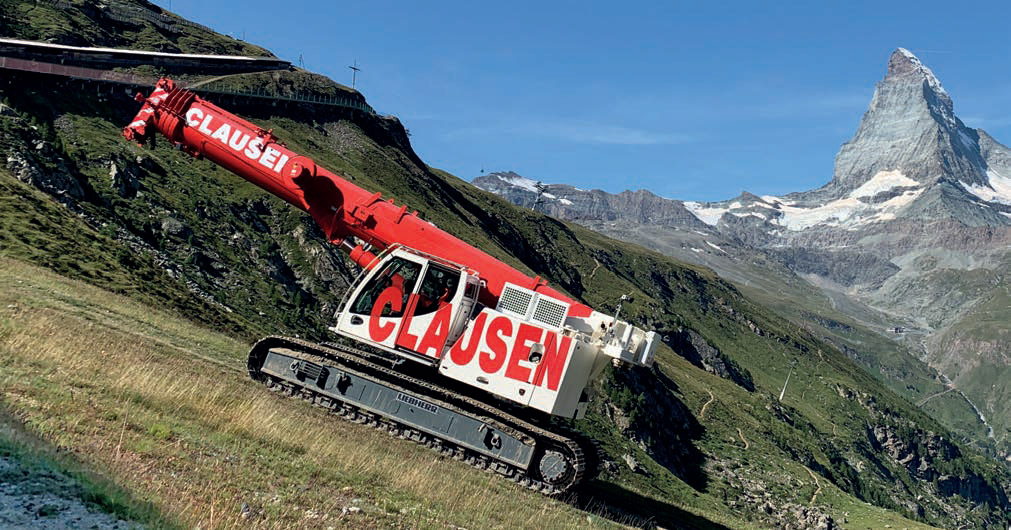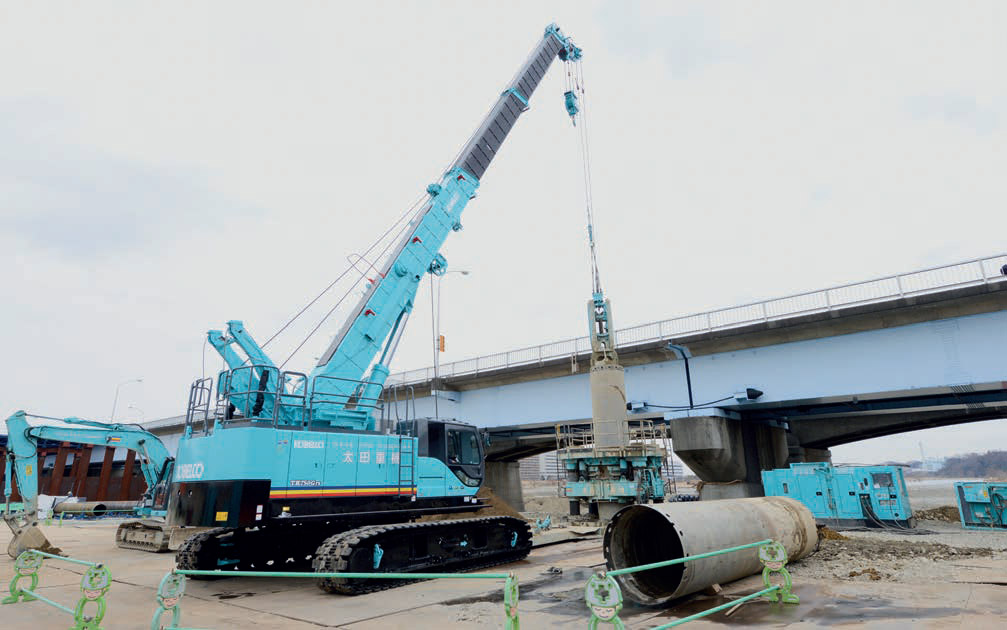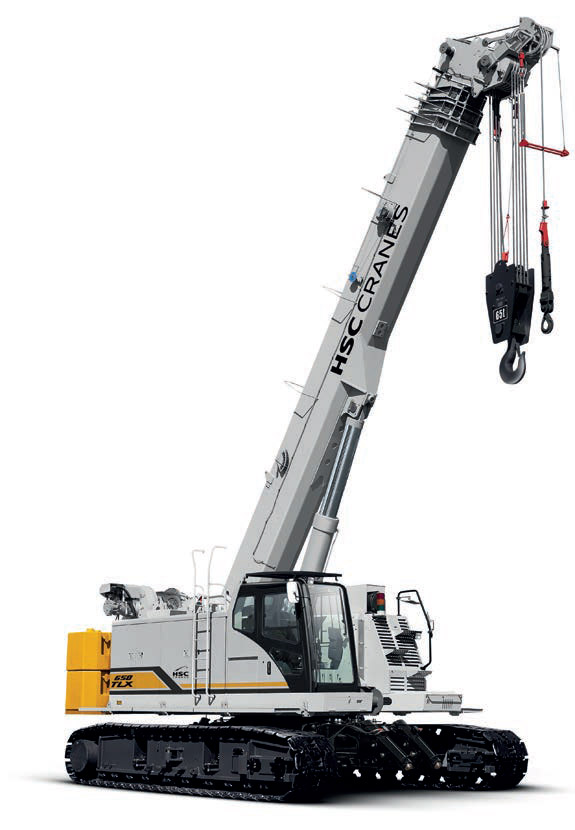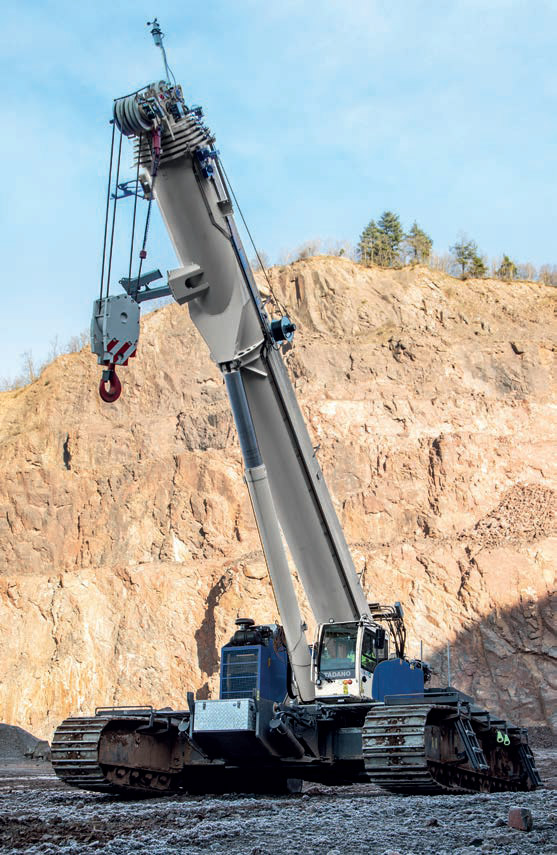Steep climb
10 June 2020Stuart Anderson, president of Chortsey Barr Associates, analyses the market for telecrawlers and identifies trends.
Over the past decade, due to a relatively steep climb in the average size and therefore cost of telecrawlers, the revenues earned by the manufacturers have increased very substantially.
While 2019 saw a relatively minor decline in global demand, according to Chortsey Barr Associates estimates, annual sales in 2018 reached almost 750 units worldwide.
Sales of larger-size telecrawlers have not been achieved in a vacuum. Virtually all of these sales resulted when customers decided to spend their money on these cranes instead of on another type of crane—either a rough terrain crane, an all terrain crane, a telescopic truck crane or indeed a lattice boom crawler crane.
As to which alternative applies, in most cases this is heavily influenced by the nature of each customer’s crane business and/or the make-up of its existing fleet. If we start by looking at contractors - buyers that undertake various kinds of construction and materials handling work, there are very distinct regional/global variations in the volume and variety of telecrawler cranes purchased.
For many years, countries or regions with soft ground conditions favoured smaller-sized telecrawlers and the main buyers were contractors specialising in building construction, particularly prefabricated concrete construction.
In some markets such as Germany, for the past decade, building contractors (as well as crane hirers) have increasingly recognised the merits of telecrawler cranes of up to 100-120t capacity. In North America, it was utility/power-line contractors that were the first major customers for smaller-sized telescopic boom crawler cranes— appropriately equipped for the specialities involved. Meanwhile in markets like Brazil and Thailand, telecrawlers found markets such as pipe laying, again in ground conditions too soft for wheel mounted cranes.
When we look at customers operating fleets of lattice crawler cranes, for many years one encountered resistance—as much to the telescopic boom itself as to the telecrawler crane. In some parts of the world, this resistance still exists, but it’s on the decline.
Traditionally, many crane buyers have been very conservative—slow to change and to accept new ideas.
Some would be able to cite good examples where such an approach has been justified. But, as always, this ‘old school’ thinking comes under pressure when a customer’s direct local competitors introduce new products to ‘their’ market.
The ‘stick-in-the-mud’ attitudes of some customers means that once a mind is made-up, it may be years before available choices are again reviewed with an open mind.
It must also be recognised that until quite recently most telecrawlers were of limited capacity and reach. This meant that customers needing high capacity or long reach, had no choice but select another type of crane.
Of course there will always be types of work for which the telescopic boom itself, let alone telescopic boom crawler cranes are less than ideal or even totally unsuitable. This includes heavy duty work such as pile extraction; duty cycle work with grabs and magnets; dredging; and so forth.
However, there are exceptions to this ‘rule’—most notably the Japanese telecrawler cranes designed expressly for heavy duty applications. While most mainstream telecrawlers are well equipped for regular ‘lift crane’ work, in many cases lattice boom crawler cranes can prove more efficient when attachments such as long luffing boom attachments are needed.
A question often posed is: how big can telecrawlers get? As I have said for many years, the sky’s the limit. The parallel is the history of the lattice truck crane versus telescopic boom truck and all terrain cranes. Many years ago makers and users of lattice truck cranes argued that telescopic cranes could never replace them— for the old plethora of reasons, including short booms, heavy booms and leaks. In fact history shows that with only one of two exceptions, notably Liebherr’s LG 1750, we have seen the death of the lattice truck crane as telescopic boom lengths have reached 100m and capacities increased to 1,200t.
If we take the traditional 100t capacity level as the benchmark, back in 1970 the question was made and indeed published in the predecessor of this journal, Cranes, whether telescopic boom cranes could ever reach the 100t level. That was blown out of the water within four years. For telescopic boom crawler cranes that landmark was achieved back in 2006 when Liebherr introduced its LTR 1100 which has since become a global success with, according to Chortsey Barr Associates estimates, approximately 400 units sold. While our industry was characteristically slow to respond, in 2007 a very small privately owned company based in Franklin, Tennessee grabbed the initiative introducing a 100USt (90t) crawler. That company was Spandeck Inc with its latest Mantis.
Of course there have also been several very large, highly specialised telescopic boom crawler cranes such as Liebherr’s 800t LTR 1800 (1990) and 1,200t LTR 11200 (2009) but the mainstream has not, to date, soared to such heights.
Recent years have seen the number of manufacturers participating in this category expand and the size of new cranes increase—two sure signs of an expanding market.
Also significantly, a number of performance-enhancing features have extended the commercial viability and application flexibility of these cranes.
Although, the activities of the Chinese manufacturers have been somewhat curtailed in the European and North American markets, these important players have rebounded very strongly not just in their enormous home market but also throughout Asia, the Middle East, Africa and Latin America. Telecrawlers have been added to the lines offered by XCMG and Sany, with FUWA and Sunward remaining important players. Last year, XCMG introduced the 120t capacity XGC 120T to supersede its earlier 100t model and also announced its largest model to date, the 220t capacity XGC 220T. The new Chinese crane has a 73m seven section boom, 108.2m maximum system length and crawlers extendable from 4.5–7.26m overall width.
Sany, too, has continued to expand its line. It’s fair to say that Sany’s first model—2014’s 100t capacity SCC 1000TBX—didn’t set the world on fire but after something of a sabbatical, the company has now added 55t and 75t models. In addition to strong sales of its 600t and 650t lattice boom cranes, India has also proven a market for Sany’s telecrawlers.
Like XCMG, FUWA replaced its 100t capacity FWT 100 with a 120t model. The FWT 120 was introduced at Bauma China 2016 and the first unit sold off the stand to Asia Group, based in Singapore.
Since joining the fray in 2007, Link-Belt has made a very strong push in the telescopic boom crawler crane market, now claiming North American market leadership. New product development has accelerated since the company became the first in the US to install boom folding capabilities in its Lexington, Kentucky facility in 2008. Since then well over 10,000 folded booms have been produced for its lines of telescopic crawler cranes, rough terrains, truck cranes and all terrain cranes of 70t capacity and greater. Two of Link-Belt’s landmark telescopic crawlers were the 75USt (70t) TCC 750 and 110USt TCC 1100 introduced respectively in 2008 and 2010. Both models became market leaders in their class in North America and were recently superseded. The 120USt TCC 1200 has already established a very strong position in its market class. In addition to the boost in its nominal capacity, the crane retains the grease-less five-section 45.7m boom that employs Teflon pads.
As with all Link-Belt cranes, the TCC 1200 and TCC 800 share the company’s Pulse crane management system that incorporates load limiting, control monitoring, self-diagnosis and on-board ground pressure management capabilities.
In 2012 Link-Belt began its collaboration with A1A Software, which resulted in Link-Belt’s iCraneTrax telematics system.
Unlike the policies of some crane manufacturers, from the outset, Link-Belt announced that all data points and fault codes for each machine are proprietary to the crane owner “who can determine whether they share the data with their Link-Belt distributor and/ or Link-Belt.” This telematics system is standard on all Link-Belt telecrawler cranes.
Announced at ConExpo 2020 was the new 80USt TCC-800 with field testing commencing this Spring and production slated for fourth-quarter 2020. Replacing the market-leading TCC 750, the new crane offers an increased boom length of 36.5m and longer total system length of 56.2m. The new crane’s jib system is Link-Belt’s exclusive ‘SmartFly’. Originally introduced in 2015 on Link-Belt’s, highly-popular 110USt HTC 86110 truck crane, the system streamlines fly assembly, ensuring proper fly erection and stowage sequences while also minimising work-at-height. Also standard is Link-Belt’s Pulse 2.0 management system with functions that include monitoring actual side-frame position and auto-selecting correct load charts. Totally new on the TCC 800 is Link-Belt’s V-CALC asymmetrical crawler configuration that, like similar systems, allows the crane to operate with any and all mixes of crawler extensions with automatically-selected charts.
The new TCC 1200 shares its undercarriage with that of the 140USt TCC 1400, which is equipped with one of the longest booms on the market at 59.5m and offers a maximum system length of 76.2m including a 16.7m three-section bi-fold jib. The TC 1400 has proven a real winner for Link-Belt, not just in North American but also internationally with units included in NRC’s UK fleet and that of Western Australian based crane hirer Tutt-Bryant. No mention of Link- Belt’s telecrawlers could pass without mention of its 250USt TCC 2500, which has established a solid position amongst North America’s crane rental community, headed by All Erection that got the ball rolling with an initial order for six units.
Meanwhile of late, the fruits of Tadano’s 2008 acquisition of the Mantis business have been evident for all to see. Virtually the entire Mantis GTC line has been completely renewed with the Japanese influence evident in boom and jib designs, crane management systems and hoists.
Recently the top-of-the-line 120t GTC 1200 (GTC 1300 in North America) was joined by the 60t GTC-600 (GCT 700 in North America) and 80t GTC-800 (GTC 900 in North America) that have both enjoyed their first European sales successes.
UK crawler crane hirer G.H. Johnson added GTC-800s to its fleet, while fellow UK company Delden Cranes added four GTC- 600s. Both sales represented breakthroughs to crane hirers long-wedded to the popular lattice crawler cranes of Kobelco and Liebherr.
Last year’s Bauma saw the launch of Demag’s first largesized telecrawler, the 160t TCC 160 which, since the completion of Tadano’s acquisition of the eponymous Zweibrucken-based manufacturer, has morphed into the 180t Tadano GTC 1800EX with a six-section 60m Demag pinned-boom plus jibs to 23m for a maximum system length of 83m and equipped with the Demag IC-1/IC-1 Plus crane management system.
In North America the crane will be rated at 200USt and named GTC 2000. Both new cranes will be available in the fourth quarter of 2020.
Introduced at ConExpo, Tadano’s new top-of-the-line model is the 145t capacity GTC 1450EX (160 USt GTC-1600 in North America), equipped with a 61m pinned main boom available with bi-fold jibs to 31.8m, or alternatively with a 32m long jib.
Tadano-Mantis’s exclusive Opti- Width asymmetric crawler width system is now available across the entire GTC line, along with Tadano’s AML-E management system with automatic load chart switching.
Although not in the higher capacity classes of telecrawler cranes, it’s clear that many UK crane buyers are eager to gain access to Kobelco’s 75t capacity TK 750G and 750GFS with their heavy-duty performance capabilities.
Despite being well-established in Japan, Asia and Australasia, to date the crane has not been equipped with a CE-compatible diesel.
The concept of the heavy-duty telecrawler has been established in Japan since IHI introduced its first 30 and 50t models in the late 1980s. IHI’s construction machinery business was acquired by Kato Works and the latest update of the 55t capacity former IHI model is now known as the Kato CCH 55-T-3, powered by a 179kW diesel.
Similarly, HSC has a solid reputation in the foundation crane market and in 2017 unveiled its latest telescopic boom crawler, the 65t capacity 650TLX. The machine has a four-section telescopic boom, with maximum boom length of 30.1m. Other features include: a hydraulic system compatible with highload attachments such as augers and vibro-equipment, a third winch with freefall mechanism, remote sensing system as well as a number of safety features.
Returning to North America, the other market player is Grove, which since 2015 has been marketing the Sennebogen line of telecrawler cranes badged as the Grove GHC line.
The most recent addition to this line is the 140USt (130t) capacity GHC 140 with a long 52.1m (171ft) main boom and based on Sennebogen’s 6133E. Grove negotiated exclusive marketing responsibility for the line in North America as well as Central and South America and the Caribbean. Thanks to Grove’s impressive distributor network, sales of the GHC line have gone well with the GHC 75 and GHC 130 doing especially well.
Chortsey Barr Associates finds that in terms of overall unit volume sales, Sennebogen remains as Europe’s largest manufacturer of full-size telecrawlers (excluding minis) but in terms of revenues, thanks to its strength in sales of larger capacity models, Liebherr still holds the crown. Sennebogen’s main sales strengths are with its 40t, 50t and 70t telecrawlers but, somewhat belatedly, the Straubing-based manufacturer has been striving to make a mark in the larger size classes. After years of producing rather conservative designs, the 130t 6133E has raised the bar with its 52.1m six-section pinned boom.
Over recent years, Italy’s Marchetti has made steady progress in expanding its line of telescopic boom crawler cranes and gained increasing international sales success. The Piacenza-based manufacturer’s telecrawler line now extends from the popular 25t Sherpina CW 25.35 through new models of 45, 55 and 65t capacity to the top-of-the-line Sherpa CW 70.42 of 70t capacity.
Liebherr has long dominated the size classes in which it competes—first with its 100t LTR 1100 and since with its 60t LTR 1060 and 220t LTR 1200. Both the 60t and 220t models seem to have had a slow start before really gaining market momentum. In the case of the LTR 1060, it’s a crane that has won particular popularity in the UK with Weldex purchasing a vast fleet of them, primarily for use on highway widening projects. The crane has also proven extremely popular amongst prefabricated concrete building contractors in the soft ground conditions of Belgium.
The big story is of the growing success of the LTR 1220. With worldwide sales estimated by Chortsey Barr Associates at approximately 100 units, this crane has established an excellent reputation amongst both crane rental companies and contractors.
While the LTR 1100 established itself as a service crane on European wind farm jobs, the LTR 1220 has established itself across a wider range of applications both in Europe and North America. It seems that when the 220-tonner was originally conceived, the global mining market offered good opportunities as a service crane in support of big mining machines.
The crash in the commodities and therefore mining markets put paid to such aspirations and, for a while, sales of the LTR 1220. Nevertheless, unit sale by unit sale, the LTR 1220 has gained favour and, over time, seems set to replicate the success of its smaller sister crane.
What next? There seems little doubt that a well-designed crane in the 300t class should find a ready market. Of course, as with the 220-tonners and indeed all medium-to-large telecrawlers, overcoming mobility challenges will be an essential part of the equation. Fast assembly and minimum truck-loads will also be vital. What might blow the market wide open would be a step-change in design that allowed such telecrawlers to compete more effectively with lattice on luffing jib projects.
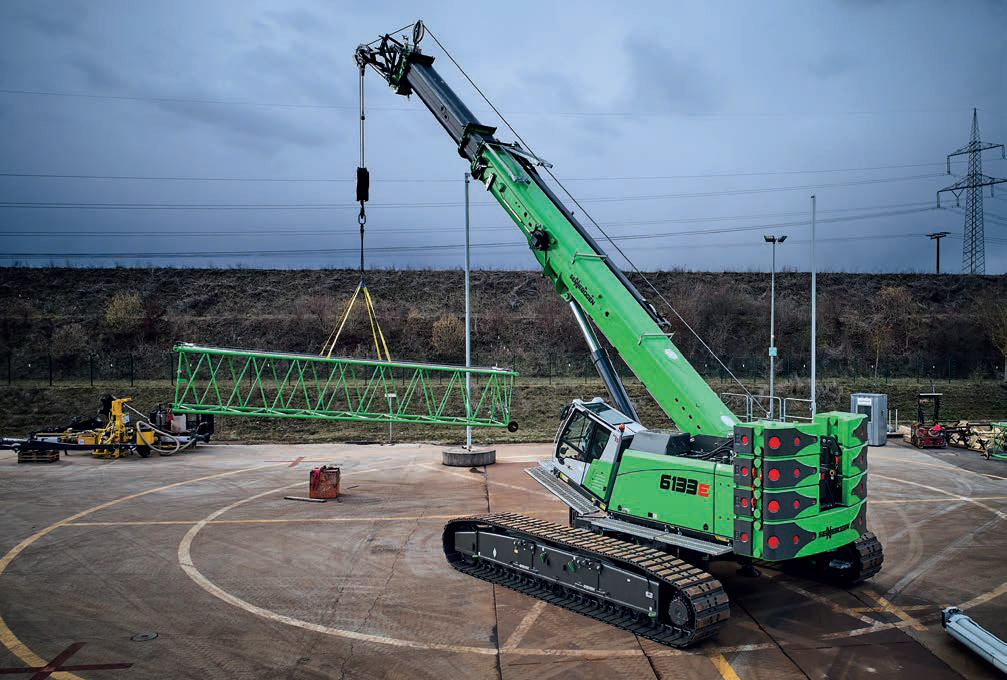 The 6133 E is the largest telecrawler in Sennebogen’s range. “It combines a high load capacity and extensive reach with fast assembly and dismantling as well as cost efficient transportation,” the manufacturer says. Its selfassembly system means that the machine can be assembled quickly without the need for an auxiliary crane. The removable crawler tracks ensure a narrow transport width.
The 6133 E is the largest telecrawler in Sennebogen’s range. “It combines a high load capacity and extensive reach with fast assembly and dismantling as well as cost efficient transportation,” the manufacturer says. Its selfassembly system means that the machine can be assembled quickly without the need for an auxiliary crane. The removable crawler tracks ensure a narrow transport width.
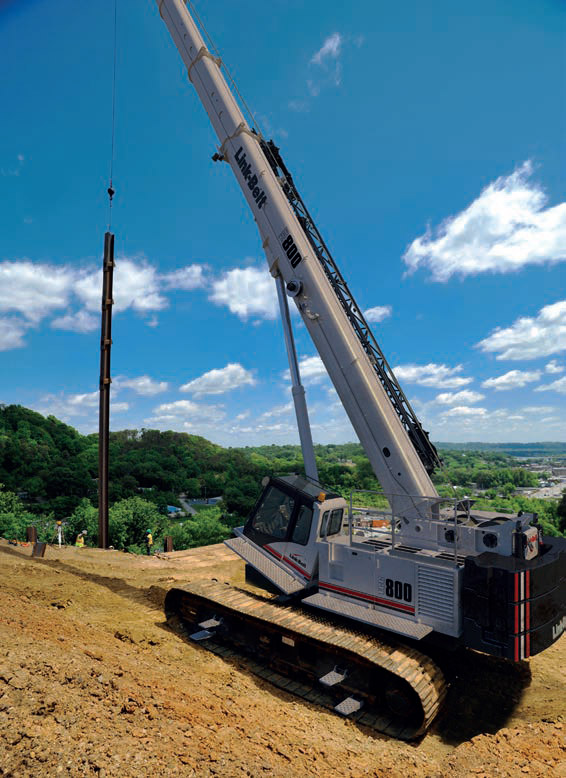 The Link-Belt TCC-800 comes with a new foursection 38ft–120ft (11.8–36.5m) full-power boom that reaches a maximum tip height of 184.5ft with full boom and Link-Belt’s SmartFly pinning system.
The Link-Belt TCC-800 comes with a new foursection 38ft–120ft (11.8–36.5m) full-power boom that reaches a maximum tip height of 184.5ft with full boom and Link-Belt’s SmartFly pinning system.
